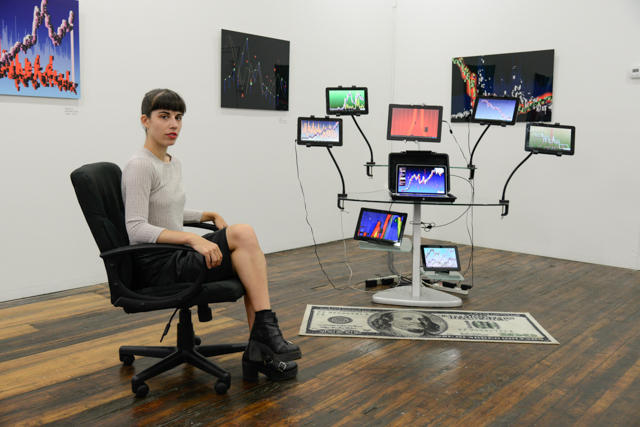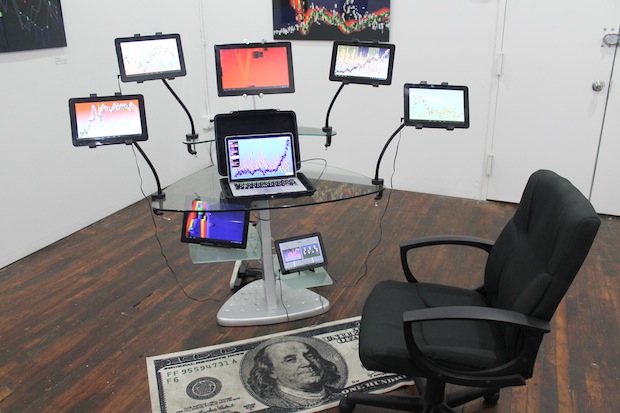
Claudia Mates at Transfer Gallery. Image: Christian Grattan
[Editor’s note: We’re featuring the work of seven artists we think you should keep an eye on throughout the end of the week. Not only are they making extraordinary work, but they’re being recognized for it as well.]
“Fucking prolific” is a phrase that comes to mind when paging through Claudia Maté’s web portfolio. Just based on the thirty-nine websites, GIFs and videos on her site, you might think she’s well into her late thirties. Her resume is equally long, listing exhibitions at MoMA, The Art Gallery of Ontario, and Wayne State University.
Maté treats web features like liquid ingredients to be poured together; there’s Cloaque.org, the collaborative exquisite corpse Tumblr, conceived of with Carlos Saez. The two seam together the digital images of invited artists into one continuous scroll. (We printed it out.) Then she and Saez took this concept to video, with unbelievable production quality. (There are currently two Cloaque movies). She makes elements of websites fall, and fly apart. Even this fun scroll feature for the earring line Ventura Carbonell has Maté written all over it.
All of this serves her bizarre wit. Maté was commissioned to make a portrait of David Bowie, for example, and she produced a GIF of a swimming, dilating eyeball. Even after looking at it for a while, you’re not sure if you’ve solved the puzzle or if it is a puzzle at all– a reference to the eyepatch Bowie wore occasionally in the early to mid-seventies? Or the fact that he had different colored eyes? In the end, we think the eyeball works as a portrait because it reflects Bowie’s creepier side. His chameleon-like qualities, his obsession with death, and the kind of genius that is often attributed to Bowie, are all represented in that one image.
Her latest show at Transfer Gallery (pictured above) was one of the best we’ve seen at the gallery yet; the show mimicked a Bloomberg terminal, aestheticizing and fetishizing charts and stock data as sleek design objects. It’s industry-level production, used to realize a sense of dark humor and wry criticism, that makes the work so sharp.
1. What defines a good artist and a good work?
A good work defines a good artist. A good work is so hard to define, though, because there are so many different kinds of good work. A good work makes you feel something, whether it’s good or bad. Or it makes you think about something after you’ve seen it.
2. Who and what influences your work?
I’m always reading about new technologies, and I try to incorporate them into my work; New software, new languages, API’s; I’m looking for new ways to connect these technologies or mix them together. It changes the work.
3. You’re from Spain. Have EU austerity measures and the economy influenced your current work or your life?
My work is not politically driven. The only work that was, maybe was my last work at Transfer, but it didn’t used to be. So, the economic situation of my country influences my life, and at that point it influences my work, but my art is not directly influenced.
4. Cloaque.org, the Tumblr you co-founded with Carlos Saez, is described as a “digital landfill” and assembled with the detritus of the Internet. It feels like the result of organized digital hoarding. What do you think drives you and other artists to collect these materials and to manipulate them? Why has the tumblr touched a nerve with so many artists and viewers? (Or has it?)
The first part of your question is difficult for me to answer, because Carlos’s idea was to use the site as a digital landfill, and mine was to mix the images between the artists and to have artists make their own work. So, there is both on the blog, but the landfill was not my idea. But I think people like it because it’s a new format, so new formats are interesting. It’s another way to collect art. It’s a unique piece that’s now two years and it acts like a timeline. The work reflects the time that people are making it in. Maybe in five years it will look completely different.
5. What is ugliness? I wonder that a lot on Cloaque, which hosts all kinds of images—cell phones, a string of pearls, weird 3D renderings—many of which don’t conform to any notion of beauty.
Perfect rendering happens in commercial fields like fashion because you need to sell something. When we look for collaborators, we’re not looking for someone who is, for example, perfect at collage or Photoshop. They need to have their own voice. Ugliness is a super open concept. With Cloaque, some people say “wow, it’s super annoying”, but others will spend hours on the site. So, what I think is ugly may not be for another person. Maybe ugly things transmit more “real”? It does something to disturb the viewer in some way.
6. What are the technical skills required to make the work you do? Could you make this work without knowing how to code?
The way I develop the ideas would be completely different without the knowledge of code. When I plan a work, the ideas come from knowing how the language works with the image. When you know how the programming works, it opens a new door in your head. I couldn’t picture how to do a lot of the work I do without that knowledge. In my last show, when I created the idea to take the data and convert it to graphs, it came from the code.
7. You’re living in New York temporarily right now, but do you see yourself living in New York in the future?
Definitely yes. I came to New York just temporarily during my solo show, but I’ve decided stay here for a while. This is a very intense city. 



Claudia Mate’s “Sweet Finances!” at Transfer Gallery
Fill Shapes from claudiamate on Vimeo.


Comments on this entry are closed.